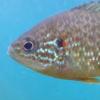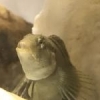So I have started a couple of threads mentioning this lately, but not this topic specifically yet. I am scheming together a 265 gallon river tank based on my "home river" the Mackinaw in central Illinois. (Link to project log here) As much as I trust most of the folks on The Planted Tank, I think I would trust this group's knowledge on keeping native fishes a bit more.
So I am settling in on a design to recreate some rheoflow (lol, I just made that word up based on rheophile) in a 7' long tank. The rough idea is here, along with a description I wrote on TPT.
 tank plan.png 195.27KB
2 downloads
tank plan.png 195.27KB
2 downloads
So this is some "high tech" graphics work in Microsoft Paint, so don't hold it against me. lol. What we are looking at here is the top down view on top, and then the side view below it.
The red baffle that would run most of the length, and the entire height. I didn't fill it in with solid color on the lower pic, but imagine that's an acrylic wall (or other material).
The green dotted lines on either end of the baffle would be either single or double lighting egg crate from Lowes/Home Depot. This would be for two reasons....first, to keep fish and most stuff out of the baffle area. 2nd is to help straighten the flow, so its more even. This is similar to how they control air in a wind tunnel.
I would like to put in 2 corner pieces (brown/tan) to sort of shape the flow and encourage the water turn a little bit. Maybe not necessary, but I think it will help efficiency. Definitely optional.
The blue-gray pieces are a stand I would create to mount a pair of pumps. For pumps, in this plan, I am thinking about a pair of the Jaebo DCT series that have the speed controller. Then I would scheme up some nozzles to spread out the flow a bit, and send it down the backside of the baffle. Additionally (not pictured) I would use this space to hang the intake and outlet of a canister filter (or two).
So I have had a few new thoughts since writing that idea up. First, instead of return pump style pumps, I think I am going to switch it to a recirculation style pump. That will be a lot more cost effective. The other thing I am considering is having the baffle slightly expand as the water flows to one side along the back...that way the water won't be really ripping when it makes that first corner, and will also help to bring up the velocity on one end, and create more of a pool like feeling on the other end. See below for what I mean.
 tank plan - angle baffle.png 194.25KB
1 downloads
tank plan - angle baffle.png 194.25KB
1 downloads
So with all this in mind, my initial thought was to try and get to about 8000gph. So breaking down into a little math....if the display area in front of the baffle on the outlet side is 16" (that's an 8" rear baffle section) and I would have 12" deep of rock and gravel for the display side (it would taper to smaller gravel and sand the further "downstream" you get) that would give an effective area of 288 sq inches, or 1.25 gal of water per 1" water column. Going a bit further, taking 8000 gph (assuming 100% efficiency), that breaks down to 2.22 gal per sec. So that means one point in water would move at about 1.78 inches per sec at the narrowest point. Then as the terrain slopes down and eases, it would create less velocity on the far end.
So obviously this is all a rough idea. The more obstacles from rocks and wood that's in the tank the less volume, so the faster the water will flow....but I wanted to see what you guys thought about those figures. Are they too fast? Too Slow? Am I overthinking this (almost assuredly, I am...that's how I roll. lol.)
Any other thoughts or suggestions are very welcome. I think the biggest challenge I am finding with a plan, however, is the sheer volume that's in this tank. Some manifold type solutions just aren't feasible.
Thanks a million!
Edited by scolba, 23 June 2017 - 08:50 AM.















